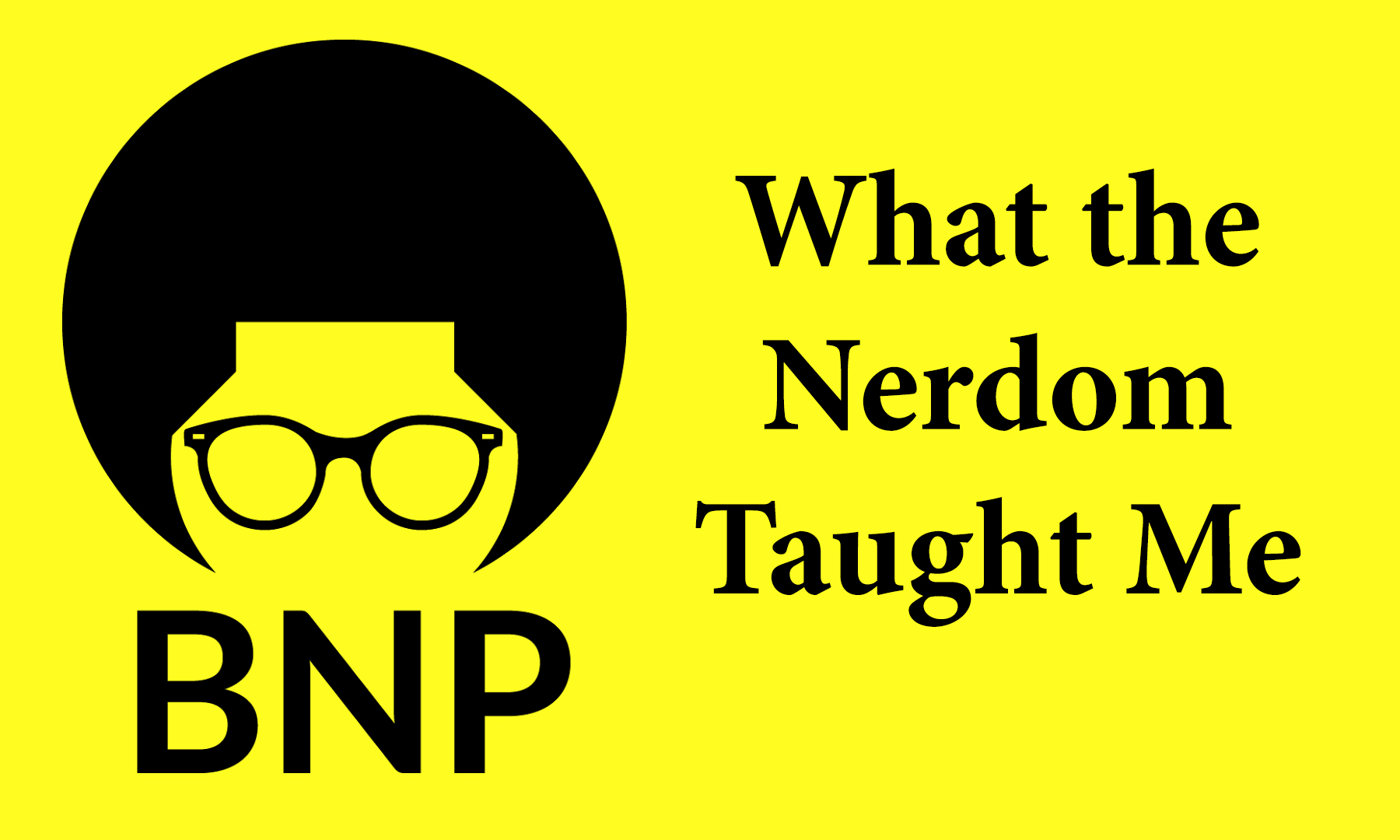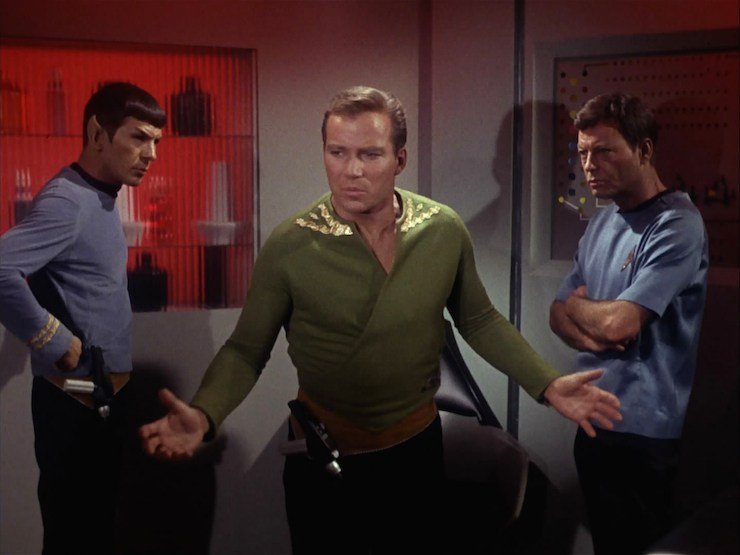We love our fandoms. For those on the outside looking in, it may be their impulse to discount our devotion as superficial or childish. That’s because they don’t understand or see how nerdom has effected us. At BNP, we know that comics and movies and anime and cosplay does so much more than entertain us, it shapes us; we learn what kind of people we want to be—and who exactly we are fighting against becoming. We sent out that bat signal, we sent out notice for an open call for submissions on what nerd lessons you learned and y’all answered the call.
The Author of This Piece and Teacher for This Nerd Lesson: Stephanee Killen, Facebook
There was a lot of Star Trek playing at my house back when I was five, but I’m fairly certain at that age I didn’t internalize much interstellar wisdom. It wasn’t until I hit my late twenties that I saw what became one of my favorite original Star Trek episodes—one that stayed with me as a nerd life lesson about balancing the light and dark within us: Season 1, Episode 5. “The Enemy Within.”
The Deepak Chopras of the world probably don’t start their spiritual journeys gathering specimens on Planet Alpha 177, but that just goes to show you never know what’s going to trigger a full-on spiritual breakthrough. For Captain Kirk, this was a return transporter malfunction splitting him into two people: “Positive” Kirk, with that classic soft focus filter making everything angelic-level dreamy; and “Negative” Kirk (K2), sporting heavy, lower-lid black eyeliner and an array of impressive facial contortions.
At first, K2 swaggers around chugging brandy out of a painted-up Dickel Powderhorn bottle, but he quickly works himself up into full-on Rampage—assaulting Yeoman Janice Rand, sucker punching red shirts wherever they appear, and hollering “I’m Captain Kirk!” to whomever will listen. In the meantime, the other Captain Kirk—who can occasionally be seen gently cradling what appears to be a docile alien Yorkshire Terrier Unicorn, also split by the faulty transporter—begins to exhibit signs of diminished mental capacity. The duplication process has extracted some essential part of himself. He’s lost his strength of will. It’s especially bad timing, since Sulu and crew are stuck on the planet’s surface about to freeze to death in negative 120-degree temperatures. Scotty is frantically trying to fix the transporter. Command decisions need to be made, and Kirk isn’t capable. In short, everything is Dire.
Spock and Kirk set out to find the latter’s hostile doppelganger and finally confront him. K2 points a phaser at Kirk, but Kirk tells him, “You can’t kill me. I’m part of you. You need me. I need you.” K2 disagrees. He doesn’t need anybody.
He’s about to prove it when Spock lays him out with a Vulcan nerve pinch. They take him back to sick bay, where Spock hits ’em all with that Logic: This is an opportunity to view the roles of good and evil in a man. The negative side is filled with hostility, lust, and violence. The positive side, with compassion, love, and tenderness. He asks what it is that makes a man an exceptional leader. His negative side makes him strong. Properly controlled and disciplined, it is vital to his strength. He points out to Kirk that the absence of his negative side has weakened his ability to lead.
Kirk knows he has to merge with his alternate self again, since he appears to be growing feeble and his double begins to die, but he doesn’t want to. He considers K2 to be a thoughtless, brutal animal. Why would he want to reunite with that part of himself?
McCoy tells him, we’re all brutal animals. We all have our dark side. It’s human. The dark side holds strength. The light side holds caring, love, and courage. Spock, who understands duality better than most, indicates that what enables him to survive the differences between his two often-contrary halves is his intellect. Scotty eventually fixes the transporter. Kirk 1 and 2 get put back together, and the question of whether half a man can live is answered: No, he cannot—but thankfully, that’s not required.
This episode of Star Trek was the first time I’d seen mainstream art acknowledge the usefulness of darker emotions. This was well before Disney Pixar’s Inside Out gave us permission to view all of our emotions as something valuable—where the writers focused on the intricate dance between emotions and how critical they are to how we view the world. Feelings such as sadness, joy, anger, fear, and disgust can form the basis for the actions we take and the interactions we have with others. That makes the interplay between emotions incredibly important.
There’s been a strong tendency, perhaps enhanced by too many Oprah Super Soul Sundays, to cultivate only our “better” half, feelings of joy, for instance, at the expense of the rest of our Self. And while cultivating compassion and love is certainly vital to social and spiritual evolution, in this particular social climate, love isn’t the only thing that will get us through.
Malcolm X said, “Usually when people are sad, they don’t do anything. They just cry over their condition. But when they get angry, they bring about a change.”
James Baldwin is often quoted as saying, “To be a Negro in this country and to be relatively conscious, is to be in a rage almost all the time.” But he goes on to talk about what we must do to control that rage so it won’t destroy us. He understood that the rage was not simply about the things that happen to us as individuals but also what we see happening to us as a community of people, the “most extraordinary and criminal indifference.”
[quote_right]Yet, we live in a society that is terrified not only of black rage but of rage, period.[/quote_right]
We have a right to our dark side—it is well earned. Yet, we live in a society that is terrified not only of black rage but of rage, period. It is often seen as the antithesis of progress. Those who argue against the usefulness of anger suggest that forward movement can only be made if we focus on the positive and any measure of perceived progress, but this tends to come from those who are afforded daily civility, safety, and the ability to distance themselves from atrocities when it gets to be too overwhelming.
This recommendation for nothing but peaceful thoughts in the face of terrible suffering is part of a system of control meant to keep people tucked safely inside the emotional and societal boundaries laid out for us. It’s part of a philosophy that suggests emotional well being can only exist if we deny most of what we’re actually feeling.
In this case, our rage is not only very appropriate but also critical fuel for the battles we continue to fight—battles for our freedom, for our rights as human beings.
Yet, every day, we read about or have lived experience of the effects of this “blatant criminal indifference,” hatred, willful ignorance, micro-aggressions, acts of violence, and an increasing number of policies meant to strengthen a system built to oppress, defeat, and deny people of color their humanity. In this case, our rage is not only very appropriate but also critical fuel for the battles we continue to fight—battles for our freedom, for our rights as human beings. We are empowered as people by a complex skein of emotions that serve as a foundation for action, for the demands we must make as citizens in a country that refuses to unreservedly offer us justice, equality, or peace.

We need that part of ourselves that houses our anger, our potency, our willingness to do what needs to be done as much as we need to recall the joy that is possible in a world where we have not yet given up our right to stand here, as we are, or the compassion we have for those who are suffering that reminds us of why we’re fighting in the first place.
We must use this to captain whatever ship holds us, our families, our communities, and the places we call home. It is true that the raw force of our darker emotions, unchecked, can jeopardize our well being and the well being of others. But working in concert with our ability to reason and love, we create a whole person, both shadow and light, cable of powerful action.
Kirk referred to his duplicate self as an “imposter,” but the shadow side of ourselves can be welcomed as an important part of our nature, a necessary force, rather than something too brutish to harbor. There is no imposter, no enemy within, so long as we refuse to view any part of ourselves as an adversary. As McCoy said, “It’s not really ugly, it’s human.”
We’re putting out the Nerd Lessons from the womenfolk first to celebrate Women’s History Month. Read the first ones we published here .
Are you following Black Nerd Problems on Twitter, Facebook, Tumblr or Google+?






Show Comments